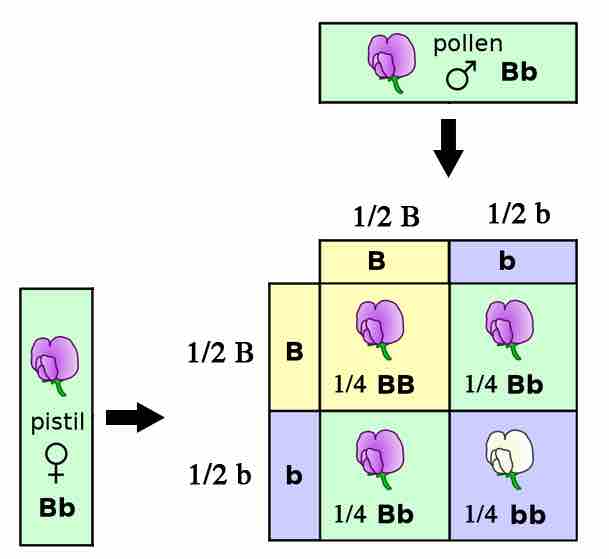Probability Basics
Probabilities are mathematical measures of likelihood. The empirical probability of an event is calculated by dividing the number of times the event occurs by the total number of opportunities for the event to occur. Empirical probabilities come from observations such as those of Mendel. An example of a genetic event is a round seed produced by a pea plant. Mendel demonstrated that the probability of the event "round seed" was guaranteed to occur in the F1 offspring of true-breeding parents, one of which has round seeds and one of which has wrinkled seeds. When the F1 plants were subsequently self-crossed, the probability of any given F2 offspring having round seeds was now three out of four. In other words, in a large population of F2 offspring chosen at random, 75 percent were expected to have round seeds, whereas 25 percent were expected to have wrinkled seeds. Using large numbers of crosses, Mendel was able to calculate probabilities and use these to predict the outcomes of other crosses.
The Product Rule
Mendel demonstrated that the pea-plant characteristics he studied were transmitted as discrete units from parent to offspring. Mendel also determined that different characteristics were transmitted independently of one another and could be considered in separate probability analyses. For instance, performing a cross between a plant with green, wrinkled seeds and a plant with yellow, round seeds produced offspring that had a 3:1 ratio of green:yellow seeds and a 3:1 ratio of round:wrinkled seeds. The characteristics of color and texture did not influence each other.
The product rule of probability can be applied to this phenomenon of the independent transmission of characteristics. It states that the probability of two independent events occurring together can be calculated by multiplying the individual probabilities of each event occurring alone. Imagine that you are rolling a six-sided die (D) and flipping a penny (P) at the same time. The die may roll any number from 1–6 (D#), whereas the penny may turn up heads (PH) or tails (PT). The outcome of rolling the die has no effect on the outcome of flipping the penny and vice versa. There are 12 possible outcomes, and each is expected to occur with equal probability: D1PH, D1PT, D2PH, D2PT, D3PH, D3PT, D4PH, D4PT, D5PH, D5PT, D6PH, D6PT.
Of the 12 possible outcomes, the die has a 2/12 (or 1/6) probability of rolling a two, and the penny has a 6/12 (or 1/2) probability of coming up heads. The probability that you will obtain the combined outcome 2 and heads is: (D2) x (PH) = (1/6) x (1/2) or 1/12. The word "and" is a signal to apply the product rule. Consider how the product rule is applied to a dihybrid : the probability of having both dominant traits in the F2 progeny is the product of the probabilities of having the dominant trait for each characteristic.

Role of probability in segregation of alleles and fertilization
In a genetic cross, the probability of the dominant trait being expressed is dependent upon its frequency. In this case, both parents possessed a dominant and a recessive gene for the trait of flower color. The dominant trait is expressed in 3/4 of the offspring and the recessive trait is expressed in 1/4.
The Sum Rule
The sum rule is applied when considering two mutually-exclusive outcomes that can result from more than one pathway. It states that the probability of the occurrence of one event or the other, of two mutually-exclusive events, is the sum of their individual probabilities. The word "or" indicates that you should apply the sum rule. Let's imagine you are flipping a penny (P) and a quarter (Q). What is the probability of one coin coming up heads and one coming up tails? This can be achieved by two cases: the penny is heads (PH) and the quarter is tails (QT), or the quarter is heads (QH) and the penny is tails (PT). Either case fulfills the outcome. We calculate the probability of obtaining one head and one tail as [(PH) × (QT)] + [(QH) × (PT)] = [(1/2) × (1/2)] + [(1/2) × (1/2)] = 1/2. You should also notice that we used the product rule to calculate the probability of PH and QT and also the probability of PT and QH, before we summed them. The sum rule can be applied to show the probability of having just one dominant trait in the F2 generation of a dihybrid cross.
To use probability laws in practice, it is necessary to work with large sample sizes because small sample sizes are prone to deviations caused by chance. The large quantities of pea plants that Mendel examined allowed him to calculate the probabilities of the traits appearing in his F2 generation. This discovery meant that when parental traits were known, the offspring's traits could be predicted accurately even before fertilization.